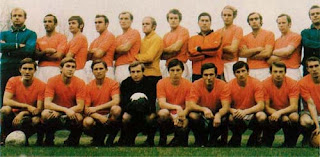Small leagues - big deal, who cares. Right? Big boys matter and they were alright, right? Wrong. Domestic football in Argentina and Uruguay was financial disaster since the 1960s. Corruption was well known feature of Italian football also from the 1960s. The Brazilian championship was plagued with corruption, back room deals, and instability from day one. The league was enlarged to accommodate big clubs finishing at the bottom and due to relegation. At one point the league had more than 40 clubs participating in cryptic championship. Big clubs forming concurrent championship, yet, somewhat incorporated in the national scheme, so it was hardly clear who was the ruling body and what constituted legal championship – at the end, every championship is legal in Brazil. The mighty British clubs were increasing debts and heading toward bankruptcy. The enormously rich Chelsea? A disaster in the 1970s, finally sold for 1 pound in the early 1980s. The ascent of Greek football, started in the 1970s, went hand in hand with heavy corruption, reaching to the top of the political system and government. Ah, Southern temperaments and British stubbornness to preserve traditional ways instead of adapting to the new realities… At least, everything was sound in the cooler climates north of France. And under the hawkish gaze of Communists behind the Iron Curtain. Hm… who should be first? The Soviets or the Germans? Soviets win after a flip of coin. Zarya from Voroshilovgrad (today – Lugansk in Ukraine) won the Soviet title. It was somewhat pleasant surprise. One has to remember that until 1960 no club outside Moscow ever won a title. The exception was 1944, if we count that: because the Second World War was still strong, there was no championship in USSR, but a cup tournament was organized in 1944. Mostly to boost moral. And for the same reason the winner was Zenit (Leningrad – now St. Peterburg)- the heroic Leningrad, a symbol of fighting spirit and resistance, appropriately won against the army club CDKA. Even the result is suspicious – 2-1, with 2 goals scored in the 35th minute (Chuchelov for Zenit; Grinin for CDKA). And again, in the name of moral and propaganda, the cup final is included in the list of Soviet championships. After that everything was back to normal – it was understood that only Moscow clubs should be champions (propaganda and ideology ruled). Dinamo (Kiev) was the first champion outside Moscow – in 1961. During the 1960s the situation shifted – instead of internal Moscow rivalries, the battle for the title became Moscow-Kiev, with Kiev taking the upper hand and occasional challenge from Dynamo (Tbilisi, Goergia). Zarya (Lugansk) was promoted to the 1st Division after winning the 2nd Division in 1966. Their most memorable moment until 1972 was in 1970, when the city apparently got new name – Voroshilovgrad. It was nice to see nobodies becoming champions in 1972, 5 points ahead (still the old system – 2 points for a win, 1 for a tie) of Dinamo (Kiev). There were no famous players in the squad, with the exception of Vladimir Onishtchenko, who got his first national team caps then, but he did not last in the club: originally a Dinamo (Kiev) player, he moved to Zarya in 1972 and was back in Dinamo by 1974.

Zarya or Zorya (the current spelling is in Ukrainian) 1972.

Vladimir Onishtchenko scoring for the national team (against France). The only player of notice from the champion squad.




